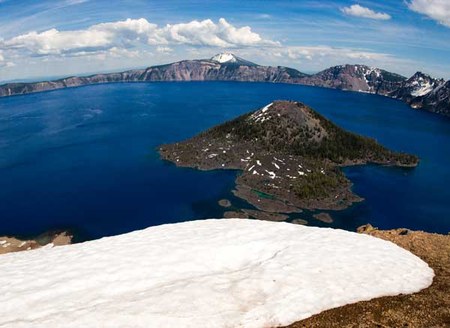
by Steve Scher
Once, a long time ago, when I was just an 18-year-old boy, I ran down the side of a mountain — into the universe.
There were five of us, traveling the nation in a van. While driving the perimeter road at Crater Lake that July, we pulled over to stare in wonder at the blue of the water, and the black of the cinder cone.
A trail led down. I followed it.
Now, you might think I was intoxicated by the scenery, by the altitude, or by other substances. You might think it was the sheer giddiness of freedom — of newly untethered kids on a grand adventure from the flat planes of the Midwest. Think what you will. I know it was more.
Running down the trail, puffs of dust released with each hard step, the small yellow and red flowers abuzz with bees and flies, the tree bark crackling in the summer heat — I sensed, running alongside me, someone else. Off to my right, keeping pace, I saw a Native American, a little older than me, with long black hair, smiling at his easy exertion. I stopped. I stared. He was gone.
A shade? A ghost? My imagination? A hallucination? Wishful thinking? Had I filled my vision with the colonized memories of popular culture? Did I think I was in the west with Crazy Horse and Tonto? I don’t know.
What I did feel, that moment and for all my days since, was the tingling sensation of connectivity.
Poets and priests of various faiths have named it, so have mystics, rock stars and scientists. It is a fleeting notion, almost always lost in the uproar of daily life.
We are stardust — as Crosby, Stills and Nash, and Neil DeGrasse Tyson tell us. The atoms that burst out of the Big Bang have expanded into meteors and asteroids, stars and planets. They’ve become the elements — the metals, water vapor, fish scales, dinosaurs, laughing babies, spilled juice bottles, the steam from that hot coffee rising into the morning light. They’ve become us.
This connectivity is just as real as electricity, every atom of existence awash in its flow.
This includes our devices, derived from the same dust as everything else. Rather than isolating us, these tools craft a shared experience that can even challenge our prejudices.
Sipping coffee at the Starbucks at Westlake Park in Seattle one day, I watched an obese and unkempt woman tote her life’s load to a nearby bench. Hair in clumps, eyes obscured by folds of fat, scarves and shirts and coats covering her like sedimentary layers, I felt the old twin bugaboos of pity and contempt welling up. How could she have let herself settle into such a morass?
So quickly she was becoming the other, the distant thing that isn’t me.
Then the phone rang. She plucked it from her pocket, flipped it open and smiled. Here was a call from a daughter or a friend perhaps. Here was a connection — one person reaching out to another. That call was a reminder to her and me. Here is a real person, with a real life and family, a part of all families.
It put my easy sympathy to shame.
We are a sharing species at our best, connected to each other in ways that are only made clear in the action.
I don’t know what that vision was 40 years ago at Crater Lake. I don’t know what cloud of particle, memory, history, I had disturbed, but the moment was real and I was connected to it, as I was to the cold blue lake, the winding trail, the snapping trees, the slurping sounds my pals were making, sipping sodas by the side of the road. I was a part of the warm metal of the van, the rubber bits from tires, sloughed off the passing cars and rising towards the hot star that burned in the blue sky.
I am still connected to that moment and to what came before — and to what comes after. It is a peaceful notion, this rolling connectivity, like the lapping of waves or the rising notes of a chorus, from phones or frogs, flowing out into space and time.
This article originally appeared in our May/June 2015 issue of Mountaineer magazine. To view the original article in magazine form and read more stories from our publication, click here.
 Steven Scher
Steven Scher